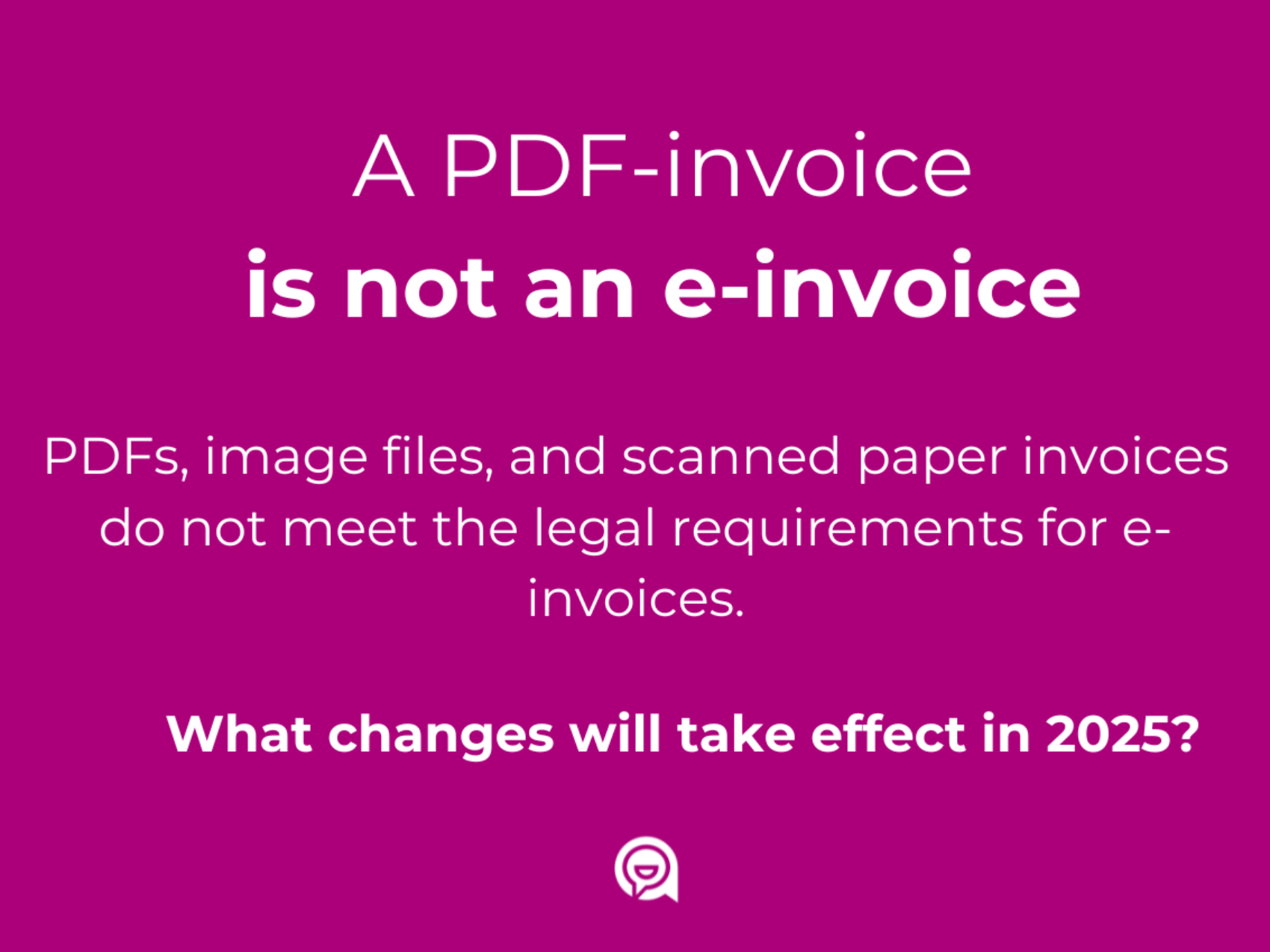E-invoice 2025
Whether you are just starting the transition or are already in the midst of the process, we are here to help you successfully navigate the digital transformation of your financial processes.
E-Invoice 2025: What Companies Need to Know
From January 1, 2025, companies must be able to receive e-invoices.
Even though there will be a transition period over the coming years, certain requirements will apply in less than a year. PDF invoices do not currently meet the legal requirements for e-invoices. The EU Directive 2014/55/EU outlines the requirements, stating that a genuine e-invoice must be structured, electronic, and machine-readable.
This change may seem challenging at first glance, but it offers immense opportunities for increased efficiency, cost reduction, and improved compliance.
The shift to e-invoicing is a response to the ongoing digitization of our society and a strategic measure against VAT fraud and to close the VAT gap. By digitizing invoicing processes, companies can meet legal requirements and gain a significant competitive advantage by optimizing internal processes.
In this article, we explore how companies can successfully navigate this transition and use it as an opportunity to future-proof their business processes. We will see that the introduction of e-invoicing is much more than a legal necessity; it is a catalyst for digital transformation in finance.

Specific and Practical Steps for Implementing E-Invoicing
The requirement to be ready to receive e-invoices by 2025 presents many companies with significant challenges. However, with the right preparation and a clear plan, this transition can be managed. Here we outline essential steps that will pave the way for your company:
1. Analyze Existing Invoicing Processes
Start with a thorough analysis of your current processes. What steps are involved, from the creation to the archiving of an invoice? Where are the potential weaknesses, and which processes can be digitized? This assessment is crucial to understand where adjustments are necessary and how best to implement them.
2. Choose the Right Solution
Not every e-invoicing solution fits every company. Important criteria include compatibility with existing systems, compliance with legal requirements, and user-friendliness. Research the pros and cons of various formats such as XRechnung and ZUGFeRD, as well as the providers of these solutions. An informed decision at this stage saves time and resources later.
3. Implementation Planning
The introduction of new software requires careful planning. Set a realistic timeline, identify key personnel for the project team, and define clear milestones. A structured approach helps keep track and ensures that all necessary steps are taken.
4. Training and Change Management
The success of a new e-invoicing solution largely depends on employee acceptance and capability. Therefore, invest in comprehensive training and actively support the change process. Open dialogue helps address concerns and communicate the benefits of the new solution.
5. Testing Phase and Evaluation
Before full implementation, it is advisable to conduct a testing phase. This allows functionality to be verified in a controlled environment and adjustments to be made. Gather feedback from users and evaluate the solution’s performance to ensure it meets your company’s needs.
6. Go-Live and Continuous Optimization
After a successful testing phase, the solution can be rolled out company-wide. However, even after go-live, it is important to continuously monitor and adjust the processes as needed. The digital landscape is constantly evolving, and continuous optimization ensures that your company remains competitive in the future.
We Advise and Implement:
To ensure the successful implementation of e-invoicing, companies must acquire comprehensive knowledge in several key areas. Here, we have summarized the most important knowledge domains:
- Legal Requirements and Standards
Companies must understand the specific legal regulations for e-invoicing in their country. This includes necessary standards such as XRechnung or ZUGFeRD in Germany and an understanding of EU regulations if the company operates in multiple countries. - Technical Specifications of E-Invoice Formats
It is crucial to know the technical details and specifications of accepted e-invoice formats (e.g., XRechnung, ZUGFeRD, EDIFACT). This ensures that the invoices you create meet the requirements and that the invoices you receive in digital formats can be processed without issues. - Integration into Existing Systems
Companies need to understand how to integrate e-invoicing solutions into their existing ERP systems and accounting software. This includes knowledge about interfaces, data export and import, and workflow adjustments. - Data Protection and Data Security
An understanding of data protection laws and security protocols is necessary to ensure the security and confidentiality of invoice data. Companies should be informed about best practices for data encryption, secure data exchange, and data storage. - Change Management and Employee Training
Successful implementation involves developing change management strategies and training employees in the operational use and support of the system. - Automation and Process Optimization
Knowledge about the possibilities of automation to increase efficiency through e-invoicing is highly advantageous. Companies should learn how to reduce manual processes and optimize their financial processes through digital invoicing. This, in turn, saves a significant amount of money. - Monitoring and Reporting
Understanding the monitoring of invoicing processes and reporting is essential to ensure compliance with regulations and increase financial transparency. This includes knowledge about report creation and the use of dashboard functions in e-invoicing systems.

